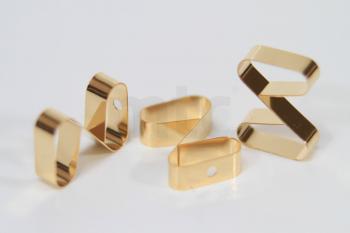In general, the tolerance class DIN ISO 2768-mk applies to
contact springs.SMD contact springs
SMD contact springs in different dimensions and shapes
Our
contact springs can be supplied in a very wide range of dimensions and shapes. Our standard range includes a huge number of different spring types in heights from 1.5 mm to 13 mm.Customized SMD contact springs
Do you require a different design or a different size than those in our standard range? Depending on your requirements and your installation situation we can also supply you with customized
springs at low tooling costs and part prices.Our technical personnel will be delighted to help you if you have any questions or require advice in the design and development support phase. We can supply you with drawings of our
contact springs in STEP or IGES format free of charge on request.Characteristics and features
The standard base material used for our
contact springs is copper-beryllium (CuBe). To order, however, we can also use other materials such as stainless steel, titanium copper or phosphorus bronze.-beryllium is easy to work and is resistant to corrosion and abrasion. Even high temperatures and temperature fluctuations or high mechanical stresses have no influence on its excellent connection properties. In addition, CuBe is extraordinarily elastic and can withstand a great deal more bending than a steel spring, for example.
Normally our
springs are gold-plated since, with the exception of “royal water” (a mixture of hydrochloric acid and nitric acid), acids are not aggressive towards gold and therefore gold provides excellent corrosion protection. In addition the gold-plated surface is ideal for soldering. Naturally other finishes (for example tin or nickel) can be supplied to order.contact springs are fail-safe and very resistant. They also have an almost unlimited service life.
Typical applications of SMD contact springs
springs are ideal for the automatic assembly of printed circuit boards. They are supplied in bulk form or in belts which means that the contact springs are perfect for mass production using standard assembly units.
contact springs are exclusively soldered on to printed circuit boards.
Application examples - SMD contact springs are used
contact springs are particularly useful for the following:
- to make contact between the PCB’s earth and the housing,
- to make a low ohm HF connection between the earthing points of two PCBs positioned one on top of the other,
- to earth cooling units on a high frequency basis,
- to connect signal and power supply cables between two PCBs positioned one on top of the other,
- to connect the PCB and elements which are not on the PCB (for example an embedded antenna) or to create external connections.
Tolerances
| Dimension (mm) | 0,5 - 3,0 | +/- 0,1 |
| 3,1 - 6,0 | +/- 0,1 | |
| 6,1 - 30,0 | +/- 0,2 |

